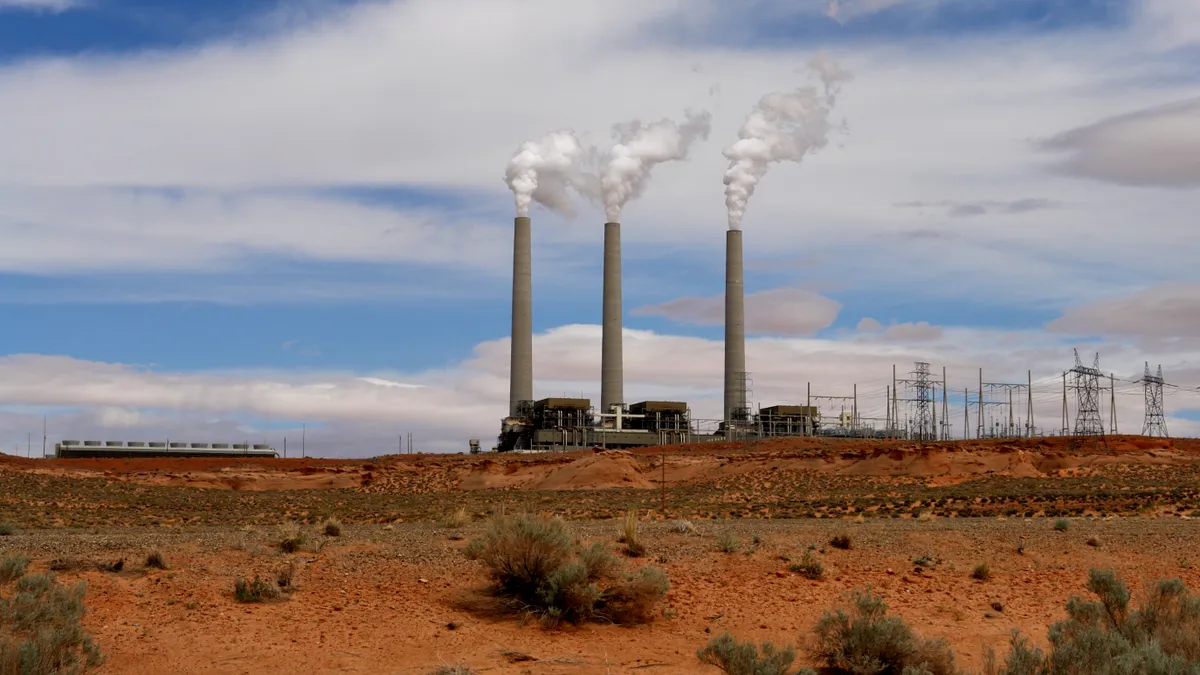Dive Brief:
- The Federal Energy Regulatory Commission last week issued a preliminary permit for a proposed 2.2 GW pumped-storage hydropower project that would use the existing transmission infrastructure of the now-retired Navajo Generating Station coal plant.
- The proposed $3.6 billion project, called the Navajo Energy Storage Station, would draw on water from Lake Powell and deliver 10 hours of renewable energy daily to markets in California, Arizona and Nevada, according to project developer Daybreak Power.
- "We believe this is the type of project that’ll ensure reliability and flexibility and deep integration of renewables throughout the region. This project is a scale that just dwarfs anything else that’s out there — and that’s what we need," Jim Day, CEO of Daybreak Power, said.
Dive Insight:
The developer filed an application for a preliminary permit for the Navajo Energy Storage Station in July 2019. The proposed facility would be located on the Bureau of Reclamation's Lake Powell reservoir on the Colorado River, as well as on Navajo Nation land on the southern shore of the lake.
The developer has proposed building an 18-mile long transmission line to connect the project to the existing transmission infrastructure of the Navajo Generating Station, which ended operations in late 2019. One of those transmission lines travels south to the Phoenix area, while another goes west towards Las Vegas — from where a large transmission path leads to Southern California, Day said.
Daybreak is looking at potential off-takers in those areas, like Salt River Project, Arizona Public Service, NV Energy, Los Angeles’ municipal utility, Southern California Edison and San Diego Gas & Electric. The company has also been looking to California’s community choice aggregators, who have been pooling together their resources to put out bids for long-duration storage resources, according to Day.
The preliminary permit granted by FERC last week would essentially give Daybreak Power priority rights to develop a pumped storage project at that site. The permit lasts for three years, during which time Daybreak Power will be conducting the studies and other work required to file a licensing application. The company hopes to file a licensing application with FERC in two years, as well as apply for a Bureau of Reclamation lease of power privilege, which would give the developer the right to use the reservoir for electric power generation.
Factoring in the timelines of all these processes, "we’d be looking at around the 2029-2030 timeframe [for] actually bringing this thing online," Day said.
Last March, the Navajo Nation filed a motion to intervene with FERC contending that the preliminary permit application should not be granted without its consent and approval of leases, permits and rights-of-way. However, FERC stated in its order last week that a government-to-government consultation with affected tribes would be "premature" at this point, since preliminary permits do not greenlight any construction. If Daybreak were to begin developing a license application, "the Commission will reach out to consult with the Navajo Nation and other affected tribes to ensure that tribal concerns and interests are addressed," FERC said.
The Center for Biological Diversity also raised concerns about the proposal before FERC, saying that the application included misleading information about the project and its public benefits, and that more detailed environmental, transmission and other studies would be required before the commission could provide it with a permit.
"Our concerns stand," Taylor McKinnon, senior campaigner at Center for Biological Diversity in Flagstaff, said in an email.
"[There] are real problems with Colorado River water availability, evaporation, and, relatedly, the climate efficacy of increasing net greenhouse gas pollution. That FERC and proponents are pushing plans for the Navajo Nation absent the Nation’s consent speaks volumes. That sort of arrogance usually leads to self-sabotage, deservedly so," McKinnon added.
FERC acknowledged in its order that various commenters had voiced concerns about how the project could affect water rights, resources, and threatened and endangered species, but concluded that these worries are premature at this stage.
Day, however, said he shares the same concerns, including ensuring that the project reduces greenhouse gas emissions, is a beneficial use of water, and doesn’t impact endangered and threatened species.
"Those are all things we need to address, we have to address… but we do think they’re all doable," he said.
Day acknowledged the concerns raised by the Navajo Nation in its filing, adding that the developer has been in discussions with them.
"[T]his project cannot and should not go forward without the buy-in of the Navajo Nation — so if they’re not on board, the project doesn’t happen," Day said.














